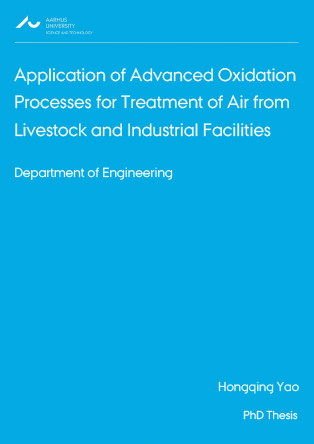Application of advanced oxidation processes for treatment of air from livestock and industrial facilities
Synopsis
Odours emitted from livestock and industrial facilities are unpleasant, and they can cause tension between producers and nearby residents and negatively affect their quality of life. It is necessary to develop proper air cleaning technologies for odour abatement. However, current technologies are limited by the removal efficiency and by the selectivity towards certain odorants. In particular, removal of reduced sulphur compounds is a challenge. Advanced oxidation processes (AOPs), as a set of chemical reactions to generate OH· radicals, are considered as an alternative technology to overcome the limitations, because the OH· radical is a relatively non-selective reactant and can react with a wide range of compounds with high reaction rate. The key hypothesis of the current PhD-project is that the odorous compounds emitted from livestock and industrial facilities, especially reduced sulphur compounds, can be effectively removed by the AOP-based reactors. The objectives were: 1) to develop AOP-based reactors for odour abatement, 2) to assess the removal efficiency of odorous compounds by using AOPs, 3) to characterize the AOP processes in detail, including assessment of the role of hydroxyl radicals, 4) to investigate relevant by-products after the AOPs from the reactors, and 5) to identify possibilities for optimization of the AOP processes.
Two types of AOP-based reactors were designed and assessed: 1) photocatalytic monolith reactors (UV/TiO2) and 2) wet scrubbers run with the peroxone process (O3 + H2O2). The processing conditions were attempted to be close to realistic conditions, such as high air flow rates and low residence time, low initial concentration (ppbv level), room temperature and ambient pressure. Proton-transfer-reaction mass spectrometry (PTR-MS) was used to monitor the concentrations of the odorous compounds before and after the reactor, as well as to investigate the Langmuir-Hinshelwood kinetic data for photocatalytic oxidation of reduced organic sulphur compounds with low adsorption. By-products from the two reactors were detected by PTR-MS, gas chromatography with mass spectrometry and gas chromatography with sulphur chemiluminescence detection.
Two photocatalytic monolith reactors were assessed. A bench-scale reactor, with one TiO2 filter installed, was used for evaluating potential influencing factors (initial concentration, air flow rates and UV intensity), establishing Langmuir-Hinshelwood model for kinetic studies of reduced sulphur compounds (methanethiol (MT), dimethyl sulphide (DMS), and dimethyl disulphide (DMDS)) and for investigating their by-product. More than 80% of the concentrations of reduced sulphur compounds can typically be removed at a residence time greater than 0.12 s and at the initial concentration lower than 150 ppbv. Data from PTR-MS were fitted very well by the Langmuir-Hinshelwood kinetic model (generally R2 > 0.99) with uncertainties of < 20% on Langmuir adsorption constants (K) and reaction rate constants (k). It is the first time to present the uncertainty of the kinetic model for highly volatile compounds. According to the investigation of the by-products, odour was significantly removed by photocatalytic oxidation of MT and DMDS. However, around 2% of DMS was oxidised to MT, which has a low odour threshold value (0.07 ppbv), to the extent that degradation of DMS is predicted (based on odour threshold values) to increase odour. Furthermore, all reduced organic sulphur compounds produced formaldehyde, which is a carcinogen. In order to reduce the production of by-products, it is suggested to connect an additional TiO2 filter in series to remove MT and formaldehyde. In a pilot-scale reactor with three TiO2 filters installed, removal of eight odorous compounds (reduced sulfur compounds, carboxylic acids and 1-butanol) was tested and more than 80% of them could be removed at a residence time greater than 0.1 s. However, H2S could not be effectively removed from the current photocatalytic reactors, and it is suggested that the application of the investigated technology is best suited for the abatement of odours that do not contain H2S.
Two types of wet scrubbers run with the peroxone process (O3 + H2O2) were also investigated. More than 90% of DMS could be removed in a bubble reactor with the peroxone process. Therefore, a packed-bed wet scrubber with direct air injection of O3 was assessed. Both H2S and DMS could be removed at with efficiency above 90%. However, the removal of MT was not as high as H2S and DMS (23.5%). It is suggested that O3 is the main reactant in the packed-bed scrubber, and that OH· radicals play a minor role under the conditions applied. Therefore, it is necessary to improve the wet scrubber. In addition, there was an excess O3 emission, and further optimization is needed to optimise the O3 uptake and to reduce the outlet concentration of O3.
In this PhD-project a thorough examination of the potential of using AOP for air cleaning with focus on odour reduction and removal of volatile sulfur compounds. Two AOP-based reactors were assessed at processing conditions close to realistic operating conditions. The photocatalytic monolith reactor could effectively remove most of the odorous compounds, except H2S, and the packed bed wet scrubber was effective on removal of H2S and DMS, but not on MT. Therefore, appropriate techniques have to be carefully selected to maximise the odour removal. Further research is necessary to optimise the reactor setup and apply the reactor on site.

